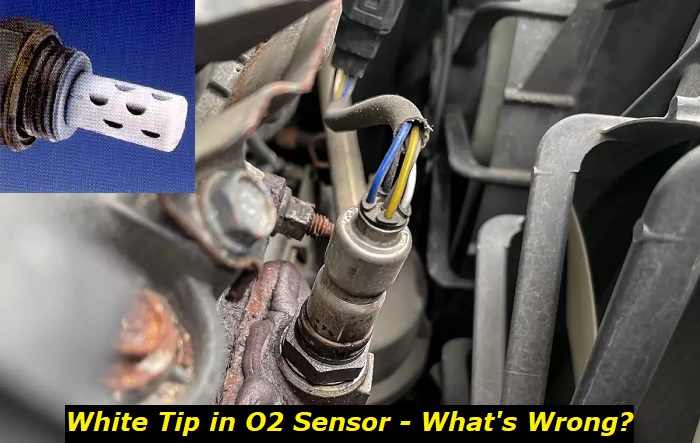If the O2 sensor's tip is white, it means that there is a buildup that could have been formed due to improper fuel, bad oil, or cheap sealant that contains some bad silicone. This buildup will almost always mean that the sensor is dead or about to die. Unfortunately, you can't clean it or bring it back to life with any other methods.
Engine exhaust problems highlights
- Level of urgency:Medium
- DIY inspection:Possible but complicated
- DIY repair:Impossible
- Cost of repair:$350 - $1,500
- Can you drive?Usually, yes
- Commonreasons:EGR issues, catalytic converter problems, O2 sensor issues, exhaust pipe problems
- Ways to fix:Locating and replacing the part that is malfunctioning

What is the white residue on the O2 sensor?
First of all, you should understand that the O2 sensor shouldn't have a white or black tip. It can be covered with a little rust, but it should be of a metal color overall. The holes on its tip should be clean. If they are clogged, you may be sure that the sensor doesn't work properly.
The white residue may be formed mainly by three factors:
- Silicone. If you've recently repaired something in the engine and used some sealant to install an important part of it, it's possible that this sealant is of bad quality and contains some bad silicone. The white residue on the O2 sensor is a very likely thing after silicone poisoning.
- Leaded gas. If you buy cheap gasoline in small gas stations or just from private sellers in rusty canisters, you will likely have a lot more problems with your car than a person who buys high-quality fuel. Leaded gas is one of the likely reasons that may cause white residue on the oxygen sensor.
- Oil burning. If your engine burns a lot of oil, this can also be the reason od the residue. But the white buildup tells you about the low quality of this oil. It contains some products that shouldn't be there and these products cause white buildup.
I don't insist that these are the only possible three reasons why your O2 sensor is white on its tip. But these three things appear to be the most important ones to check. If you still can't find the reason, possibly you should go to the specialist and have your car inspected. This will help you locate the actual reason and understand if you actually can save the sensor.
Can you clean the white residue from the O2 sensor?
Potentially, you can clean the O2 sensor, but it will not bring it back to life. If the sensor is broken and it throws the code in the ECU (check engine light), it means that there is little to no chance of making the sensor work again.
You may physically clean the buildup from the tip of the sensor, but the working part of the unit will remain clogged and will not be able to send the proper readings to the ECU. As a result, the emission control system of your car will go mad.
So, if you took out the O2 sensor by chance and spotted the white residue, you can clean it and install the old sensor back. It will likely work for some more time. But if you take the sensor out after it throws the check engine light, it will most likely be dead, and cleaning it won't help at all.
How to prevent white buildup from forming on the sensor?
If you want your O2 sensor to live a long and happy life, there are several things you can do. Here they are:
- only use high-quality fuel with proper octane number and with no lead in it;
- make sure you go to a good mechanic when your car needs service;
- buy proper parts when repairing your engine;
- don't use cheap gasket sealers and silicones;
- use high-quality oil, prefer the OEM offers;
- change the oil regularly and make sure the engine doesn't burn a lot of it.
Also, if you see that your vehicle is overheating or there is an error code that triggered the check engine light, you should have the vehicle inspected as soon as possible. If you keep driving with these problems, the emission system will most likely fail very soon.
Final thoughts
I believe you will not worry much about the health of the oxygen sensor until this part dies and you figure out how much it costs. But it's a good idea to try and prevent problems instead of creating them and then trying to solve the issues.
Make sure you know the symptoms of a bad sensor and what exactly causes problems. With this knowledge, you can easily prevent the O2 sensor from failing and save a significant amount of money.
About the authors
The CarAraC research team is composed of seasoned auto mechanics and automotive industry professionals, including individuals with advanced degrees and certifications in their field. Our team members boast prestigious credentials, reflecting their extensive knowledge and skills. These qualifications include: IMI: Institute of the Motor Industry, ASE-Certified Master Automobile Technicians; Coventry University, Graduate of MA in Automotive Journalism; Politecnico di Torino, Italy, MS Automotive Engineering; Ss. Cyril and Methodius University in Skopje, Mechanical University in Skopje; TOC Automotive College; DHA Suffa University, Department of Mechanical Engineering






Add comment